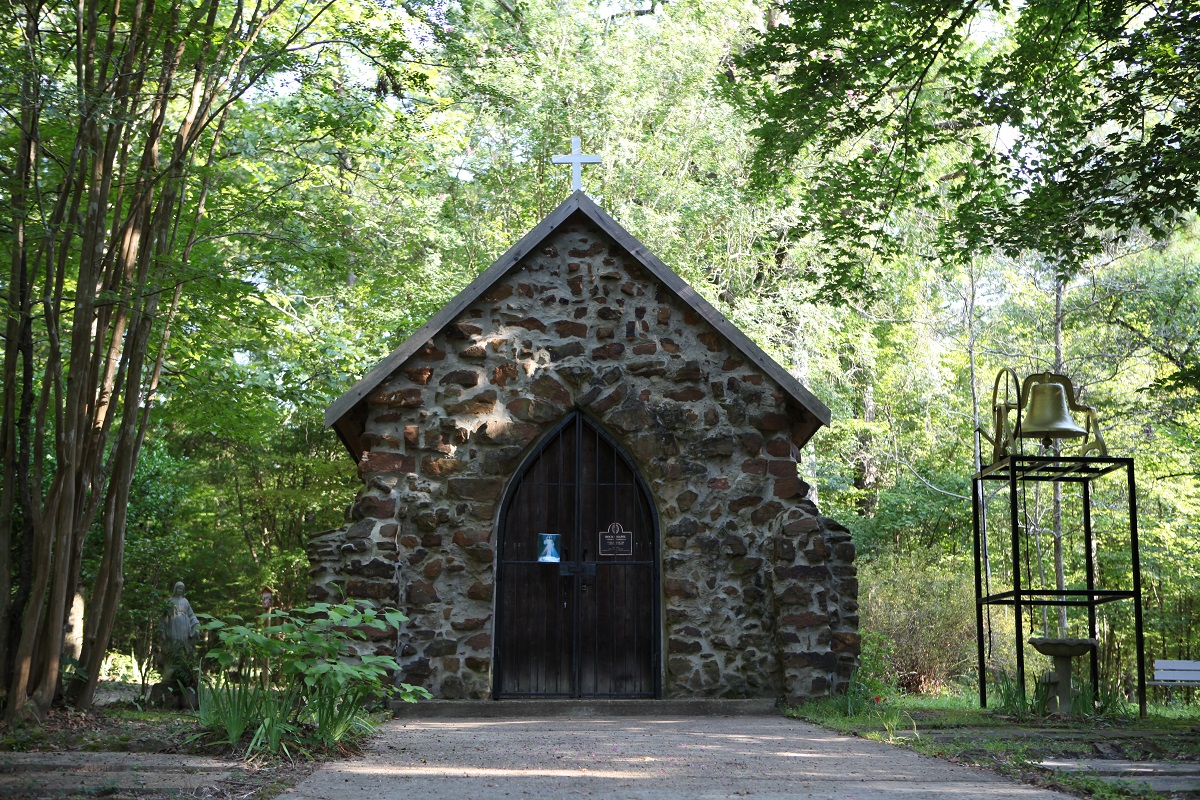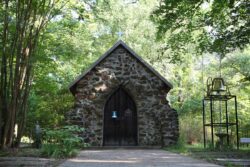Chapel in the Woods
Carmel’s Rock Chapel offers visitors a fascinating peek into the history of DeSoto Parish
Published: November 30, 2020
Last Updated: June 1, 2023

Photo by Chris Jay
From the point where it crosses Interstate 49 at Exit 177, Louisiana Highway 509 winds southward through DeSoto Parish toward Mansfield. Travelers will pass dozens of gravel and red clay roads, most of which bear the names of oil and gas exploration companies. Down one of those nondescript roads, however, visitors will discover an entirely different kind of treasure than what is being hauled by the tanker trucks that trundle up and down the highway.
Named one of the “South’s Most Beautiful Chapels” by Southern Living in 2018, Rock Chapel was erected in 1891 by an order of Carmelite monks who’d traveled from West Texas to DeSoto Parish in 1888. Within a year of their arrival in the area, the monks had established a bustling outpost that included a monastery, a bakery, a workshop, and other buildings. Under the leadership of Father Anastasius Peters, the monks also built a tiny chapel on a hill, carrying stones from nearby fields and using creekbank mud as mortar. The footprint of the structure measures only fifteen feet in width and twenty-five feet in length, too small inside to accommodate pews. The heavy, wooden chapel doors open to reveal a humble sanctuary: six chairs, three windows, a kneeling bench and a simple altar. During a 1961 restoration of the chapel, Mansfield artist Eugenia Manning painstakingly recreated the sanctuary’s colorful frescoes. The monks dedicated their new chapel under the name the Riches of St. Mary, though it is more commonly referred to as St. Ann’s Rock Chapel or simply Rock Chapel.
Historical accounts differ with regards to the purpose of Rock Chapel. Late historian Eric J. Brock, writing for the Shreveport Times in 1998, concluded that it was used as a space “to minister to the black population, many of whom were former slaves or the descendants of slaves and had theretofore found little support from their white neighbors.” Brock’s version of events posits Rock Chapel as “the first private school ever open to blacks in DeSoto Parish” and “a training place and devotional center for black Catholics in the area.”
In contrast to Brock’s reading of the purpose behind Rock Chapel, many articles written by regional historians over the years have stated that the chapel was simply a space where the monks could seek spiritual refuge from their increasingly busy surroundings. “The Rock Chapel was built for the monks as a place to pray, worship and study in seclusion,” Andrew Griffin wrote in a 2003 article for Alexandria’s Town Talk. “It was built for prayer and probably was used by only one or two monks at a time,” Charlotte Burrows reported for the Times in 1989.
But these accounts, and others like them, provide only vague reasons for the sudden demise of the monks’ community at Carmel, which seems to have plunged into turmoil in the early 1890s. Clare D’Artois Leeper’s 1963 account is characteristic of much reporting that simply opts not to explain the demise of the Carmelites. “In 1896, Father Peters, for some unknown reason, was recalled and soon afterward the sisters of the convent left also,” Leeper wrote for the Times. Between 1891 and 1896, a number of Carmelite monks and sisters died, including two monks who were shot dead by a white parishioner of nearby Holy Apostles Church. According to Brock, local white citizens sought to discredit and undermine the Carmelites, who they feared would alter the relationship between Blacks and whites.
In 1894, Father Peters tendered his resignation. By 1896, he’d departed America for Austria, followed by several other monks and nuns. A fire (referred to as a “garbage fire” in some articles) burned the monks’ residence in 1896. In the spring of 1897, an order from the Vatican officially ended the missionary work of the Carmelites and, in 1904, another fire burned everything but Rock Chapel and the nearby convent. Over the following century, Rock Chapel weathered extended periods of neglect punctuated by occasional renewal efforts. The structure and interior were restored extensively in 1961, but by 1973, a local headline read “Rock Chapel Lies in Ruin.” The dirt road used to access the chapel was widened during the 1961 renovation, inadvertently creating a lover’s lane that led to rampant vandalism of the property throughout the 1970s and 1980s.
Today, Rock Chapel is well looked after. The location is easily accessible by car, with a simple picnic area onsite and concrete steps leading up the steep creekbank to the chapel. Though it has long been a destination for those seeking a place for quiet spiritual reflection, Rock Chapel’s oft-revised history also demands that it be considered as an important site in the history of post–Civil War race relations in Louisiana. If you go, the address is 1746 Smithport Lake Road in Mansfield; the caretaker, Mr. Vance Shaver can be reached at 318-461-2971.
Chris Jay is a freelance writer based in Shreveport, where he publishes the local food and drink newsletter Stuffed & Busted. He and his wife, Sara Hebert, produce All Y’all, a podcast and live storytelling event series.
